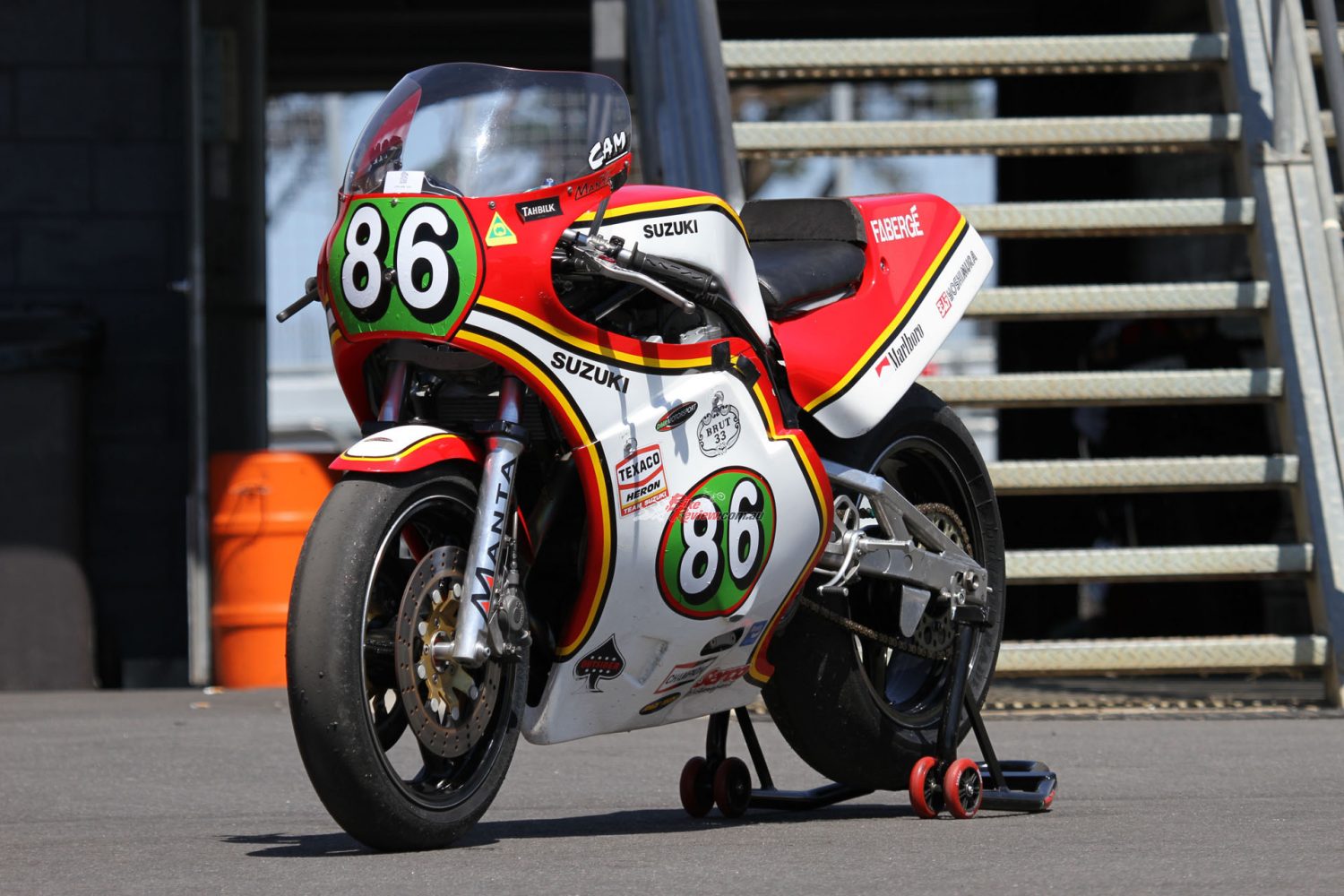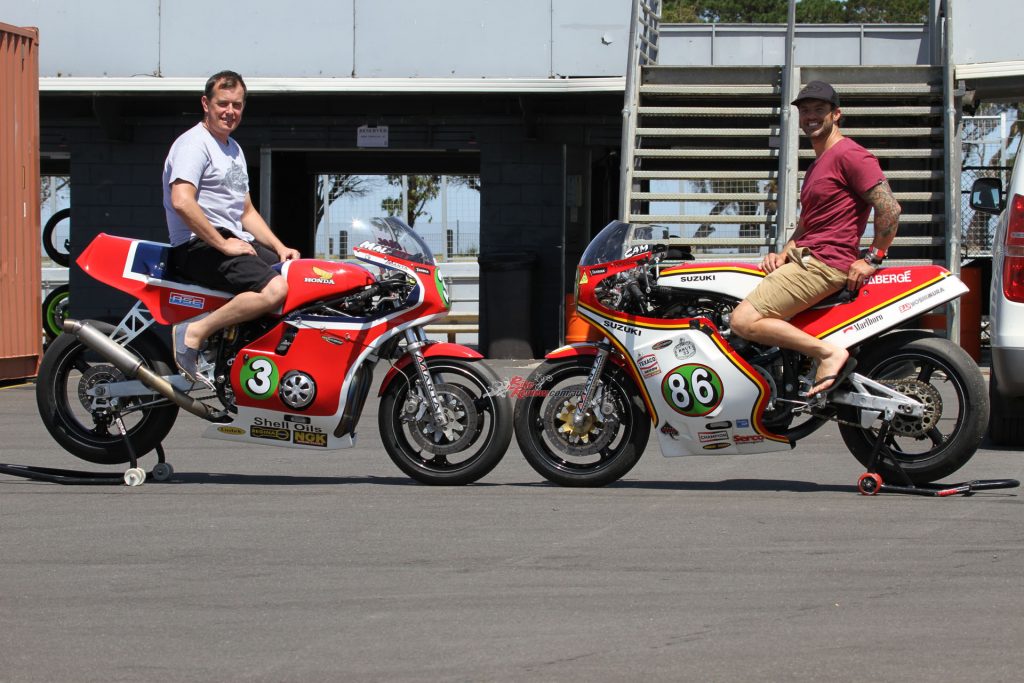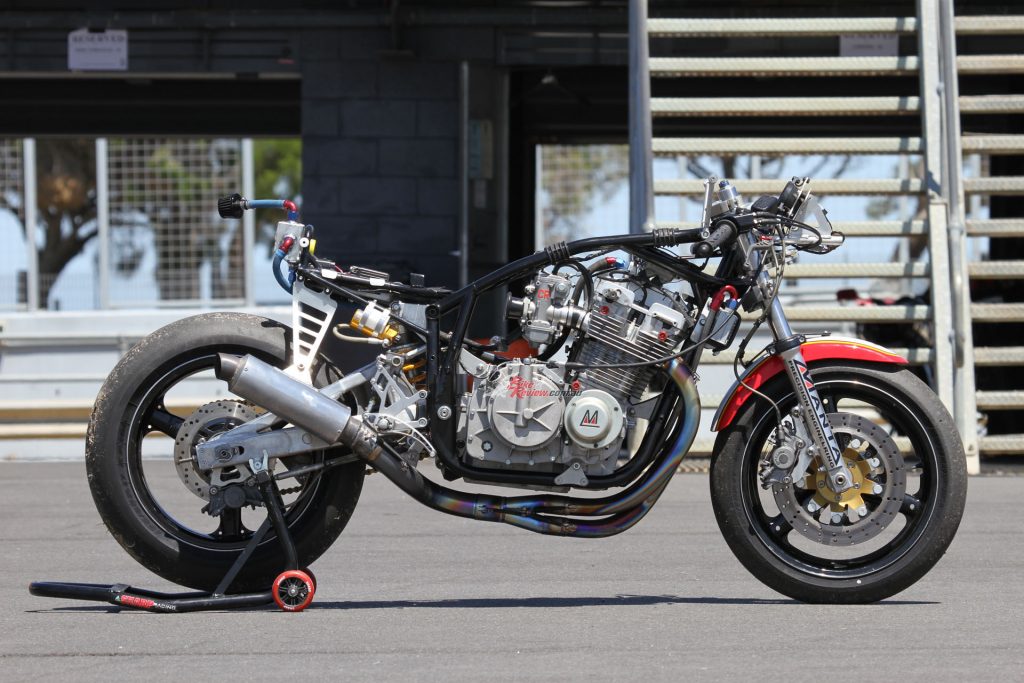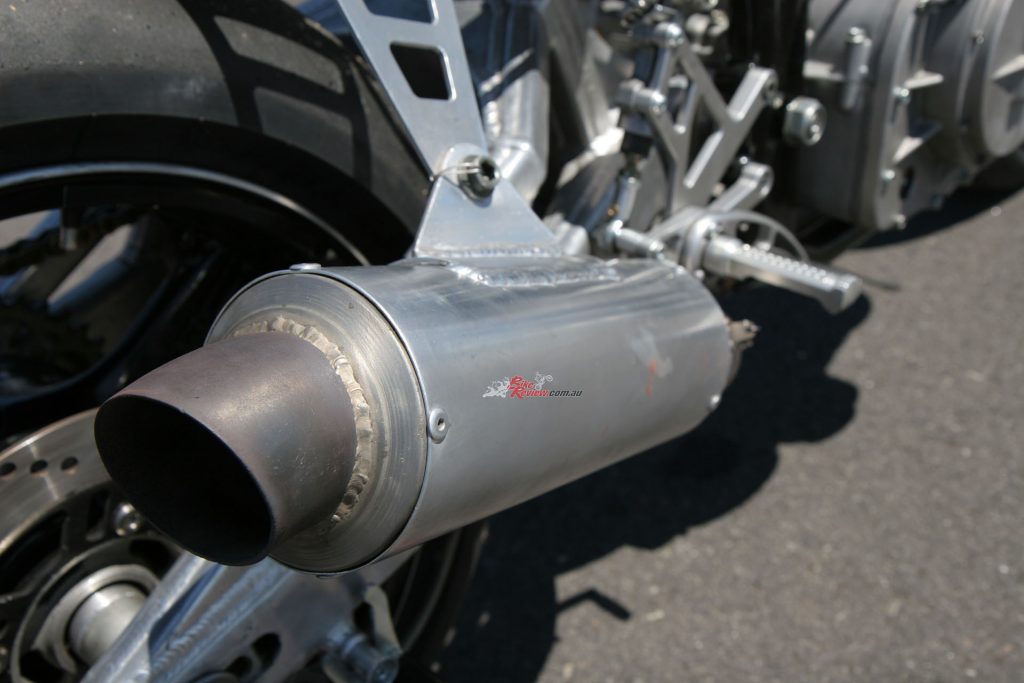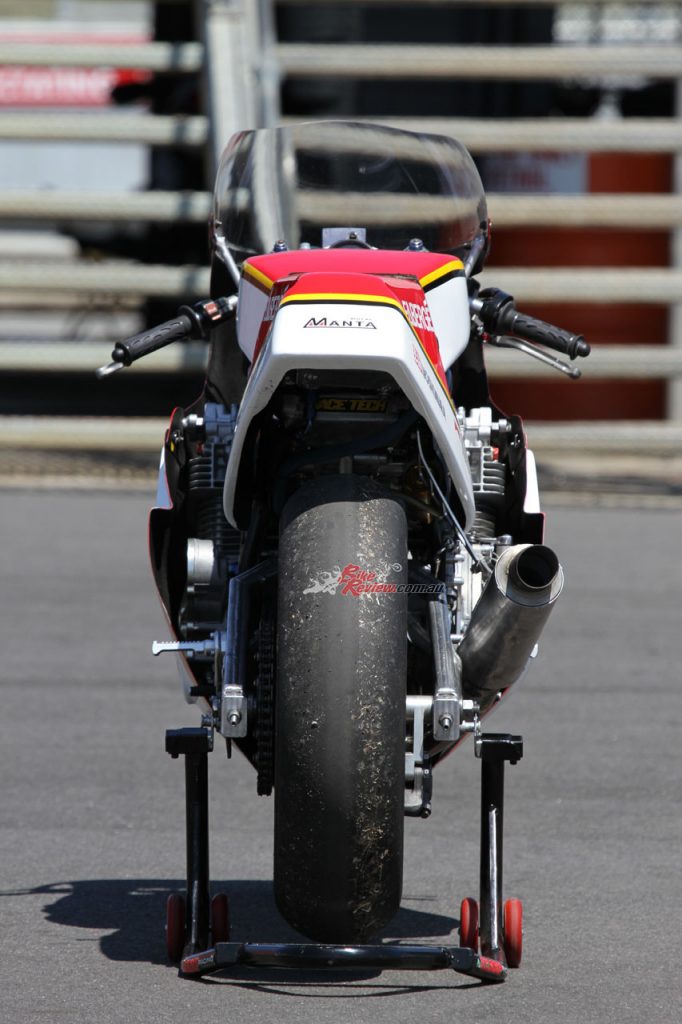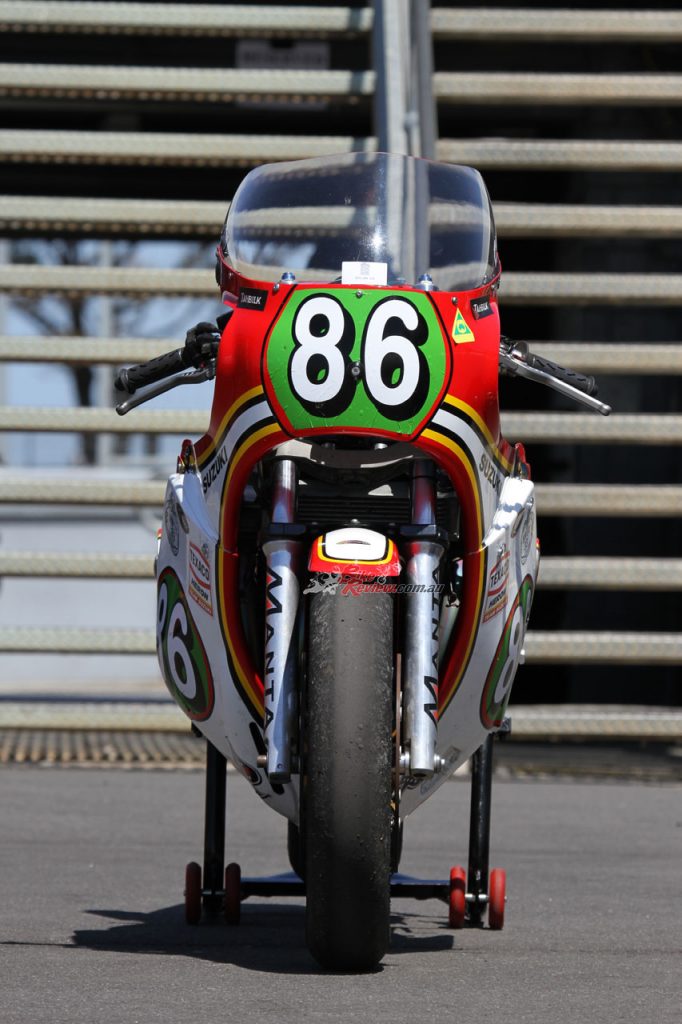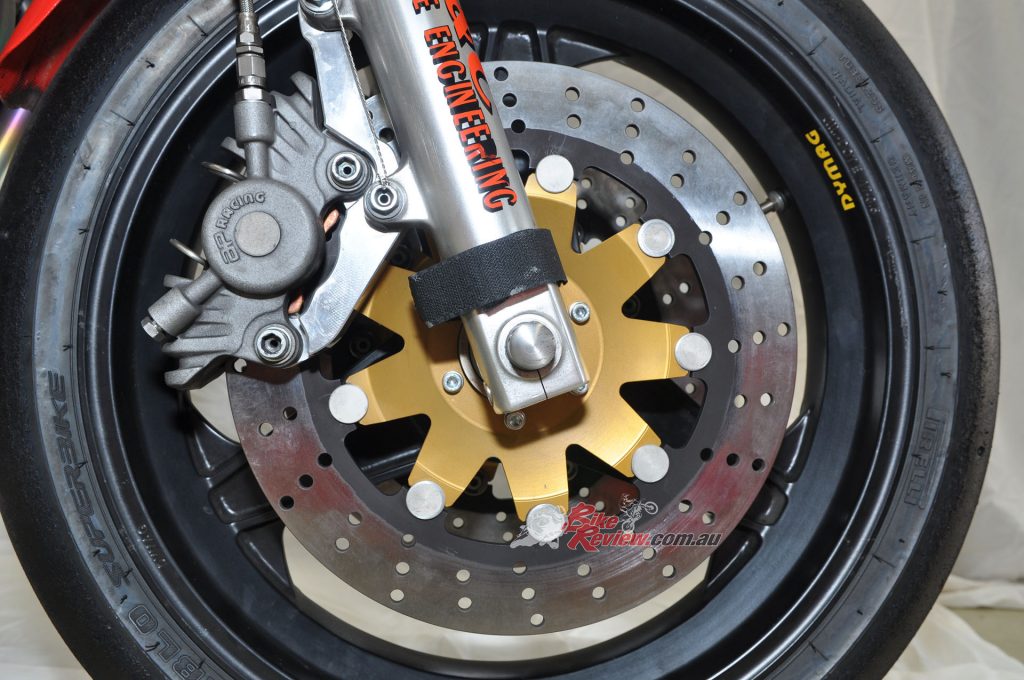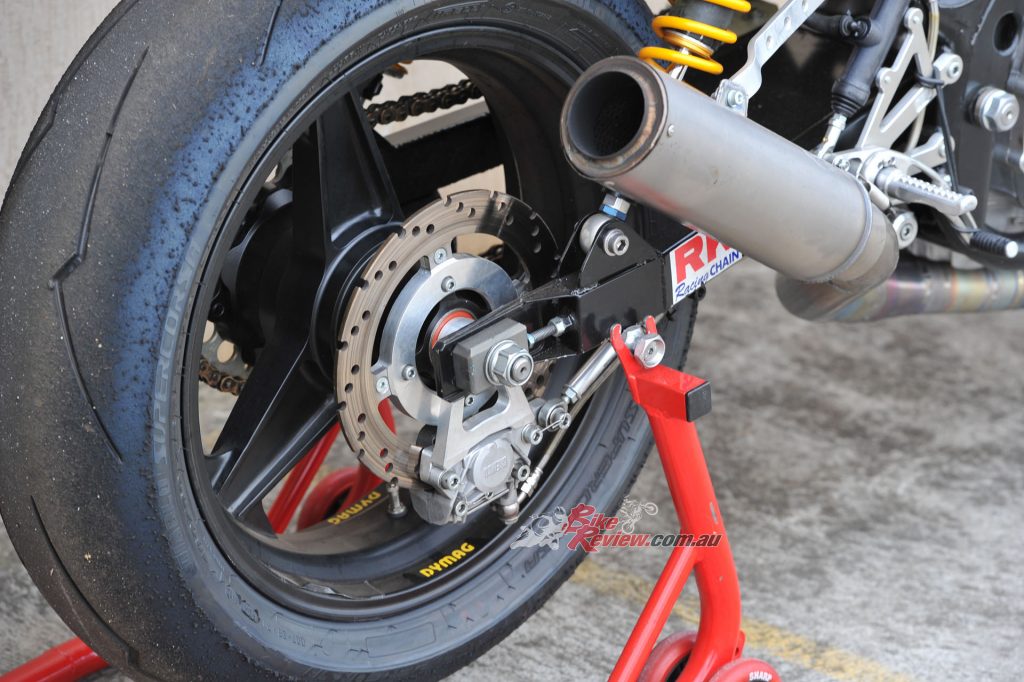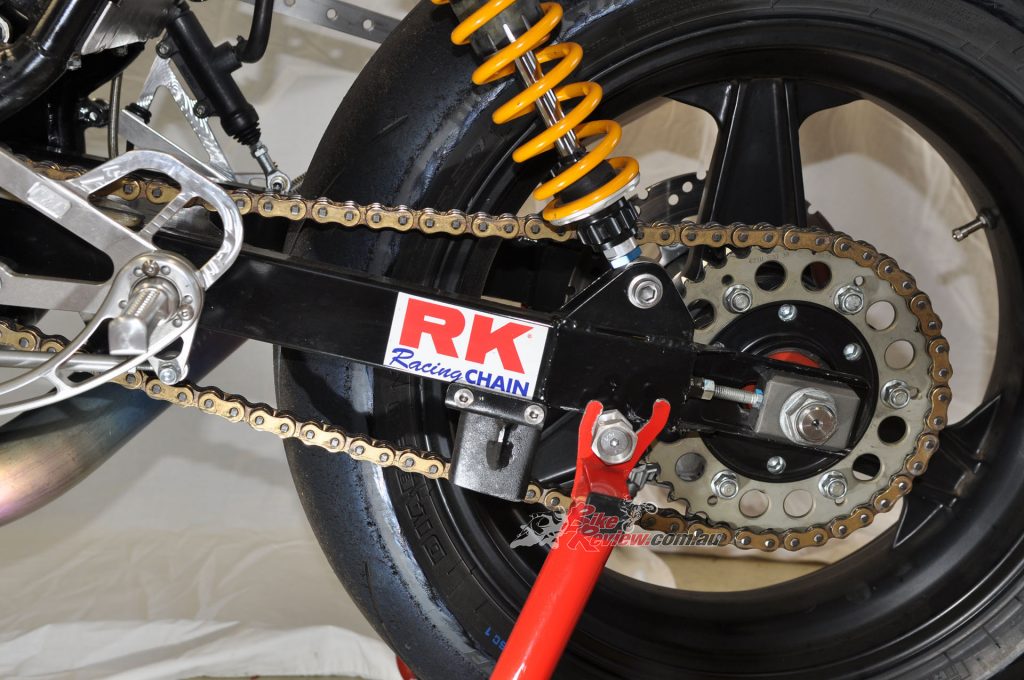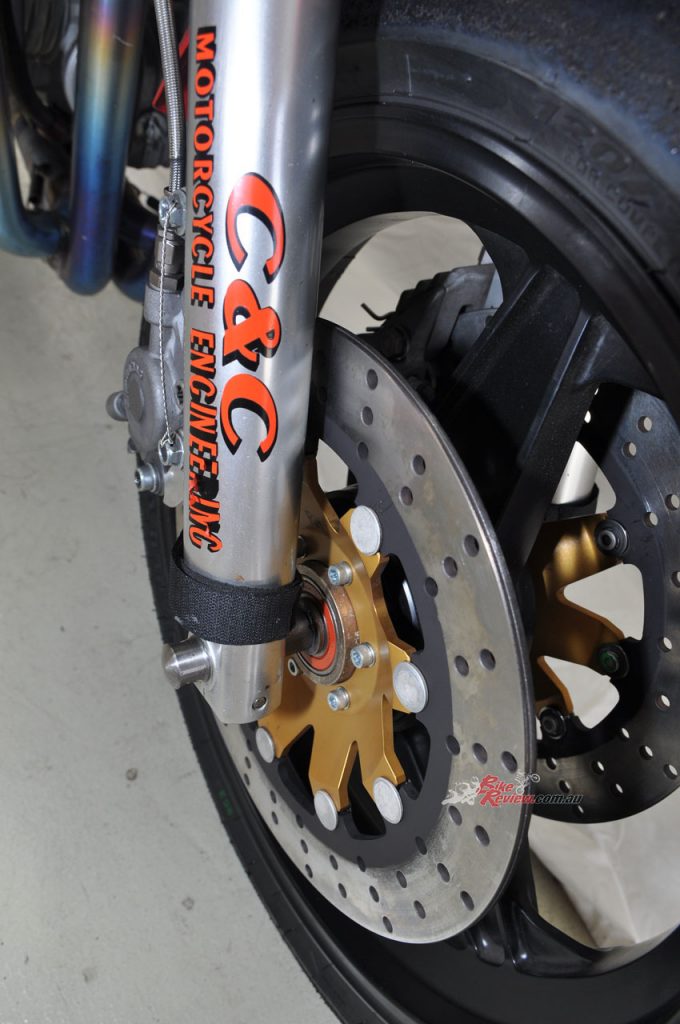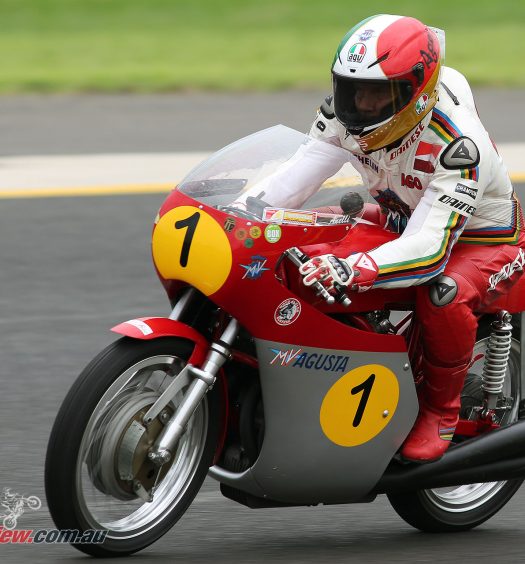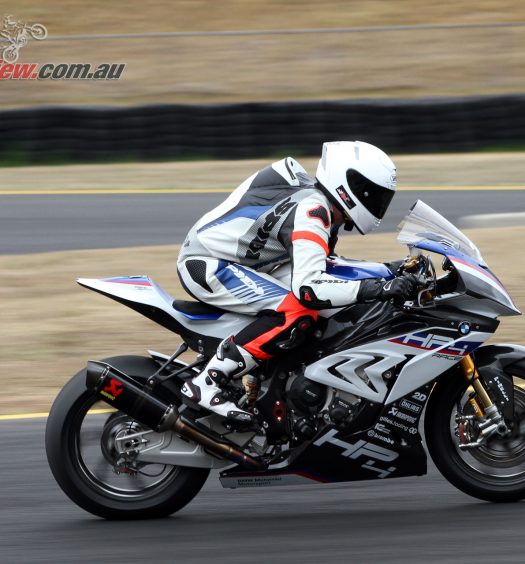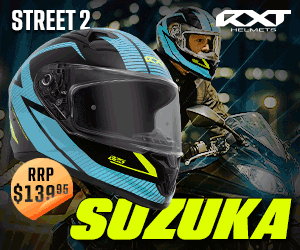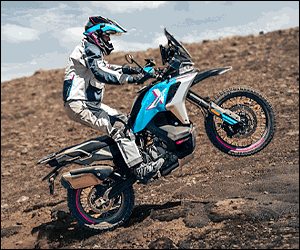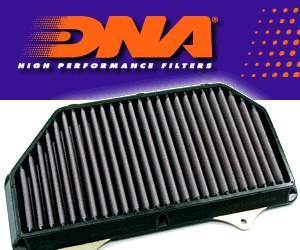Tom Dermody's Harris XR69 replica, built with help from Peter Magwiggan, Paul Walkley and Trevor Birrell; and raced by Cam Donald. Words: Jeff Ware, Photography: Heather Ware
Cameron Donald is a household name in the Australian motorcycling community for his Isle of Man status but equally as popular are his results in classic racing. He’s won plenty of races over here and at the Phillip Island Classic he has raced a very special bike…
This is one very special bike and it took pole with a 1:38.368 at the Island along with winning race three ahead of of Jeremy McWilliams, Shawn Giles, Steve Martin, John McGuinness and other legends.
The bike has been improving every year with the help of Cameron’s riding talent and experience, along with the great engineering minds and racing experts behind the Aussie legend. There’s no doubt, this is one special machine and it’s a thrill to see it out on track…
The owner of the Manta Racing XR69, Tom, is an avid enthusiast and motorsport petrol-head from Brisbane.
Tom also owns the RS1000 Honda that Mal Campbell raced at the Phillip Island Classic, along with a few other tasty classic bikes as you can see in his profile list.
The XR69 story came about like most good classic bike stories – it stems from memories burnt into the back of Tom’s mind, watching heroes like Joey Dunlop and Roger Marshall racing bikes in the Irish Road Racing Series in the early 1980s, before Tom moved Down Under.
Like so many of us, later in life when the hard work starts to pay off, we revisit our younger years and because none of motorcyclists ever grow up, we get stuck in our favourite era and start collecting bikes!
Tom bought this one quite some time ago. In fact, it was way back in 2007 that he took delivery of the XR from the UK. He purchased the bike straight from Harris Performance in the UK as a frame kit and bodywork then went about building it into what we see today, a masterpiece of modern and era parts.
The engine, a TBR special just like those in the TBR Katanas I rode at Phillip Island, is based on a GSX1100 rather than the original GS1000 that the XR69 was based on. The cylinders have been resleeved and punched out to a whopping 78mm and stroke is 66mm.
The pistons are custom-made JE forged alloy items, swinging off top shelf Falicon knife-edge conrods. The crank itself is lightened, welded and balanced. OEM main and big-end bearings are used.
The cylinder-head is ported and flowed by TBR and runs Yoshimura camshafts, 31mm (IN) and 26.5mm (EX) valves. The original GSX1100 crankases are retained with some modifications and the gearbox is also GSX1100 with undercut gears. A Manta clutch is used as well as a Manta oil cooler.
The exhaust sytem is a stunning titanium Yoshimura period system with a Yoshimura muffler and on the intake side of things, a quartet of popular Mikuni CR35mm carb’s are fitted with velocity stacks. The bike runs on Avgas, ignited by a programmable Dyna 2000 ignition system and NGK spark plugs. Tuning is done by TBR.
The Harris XR69 frame is made from ultra strong, ultra lightweight Reynolds Tubing, with additional gusseting and bracing by famed Victorian bike engineering firm Manta Enterprises. Manta are also responsible for the triple-clamps, fork brace, rearsets, handlebars, shock linkages, modifications to the Harris swingarm and for altering the geometry of the frame. The frame was then sandblasted and painted.
Race Bike Services in Adelaide built the suspension for the bike. Yamaha R6 forks are set-up with Ohlins internals and the Ohlins shock has had the Race Bike Services treatment, with both ends developed over the years with Cameron, including trying a variety of shock linkages and ratios.
The wheels run Dunlop slicks, the rear wheel is from an early Kawasaki ZX-6R and the front from a Suzuki RF900, while the stunning brakes are again Manta cast iron rotors with AP Lockheed two-piston calipers, Venhill brake line and Bendix carbon-matrix brake pads up front, squeezed by a 14mm master-cylinder. At the rear there is a single Brembo two-piston caliper, Manta rotor, Venhill brake line and Bendix pads.
The bodywork is Scott Webster modified Harris fibre-glass with an aluminium fuel tank and Manta alloy oil tank. Paint and signage was done by Custom Colour in Heidleburg, Victoria.
Tom won’t reveal how much cash he has sunk into the bike over the years but he’s happy with the machine and would do it all over again. These type of builds are love jobs, and putting top level riders on them, such as Cam Donald, must be a fantastic experience even if they do get destroyed from time to time!
Graeme Crosby and the Suzuki XR69
Graeme Crosby has publicly stated “These bikes were my favourites.”
Based on the GS1000 engine, Suzuki raided the 500cc GP spares department for a lot of parts like forks and brakes. Development was handed to Pops Yoshimura and with his team at Yoshimura Japan, they created and finessed an extremely capable bike.
We’ll leave the final word about the original to Croz, “We had fun with this bike. It gave me plenty of victories including two World Championships and two TT wins. The 1981 version was the best with the introduction of the full floater suspension.”
Possibly the most-replicated race bike of the past 40 years, you can buy a very good replica but good luck trying to find an original.
Cam Donald on the Harris XR69
My first time on this bike was at the Phillip Island Classic back in 2011, this was also my first race on a “Classic Superbike”. Prior to that I had raced a 1962 Manx Norton at the same event and looked on at this class of racing.
When I watched mates Steve Martin and Jeremy McWilliams dicing it out on these magnificently presented big capacity machines I knew that I wanted a piece of the action!
Speaking to Rex Wolfenden after the event he put me in contact with Tom that owns the XR69 and Peter McWiggan from Manta engineering that built the bike.
My first time on the bike was a learning experience, straight away it felt a lot more like a “current” race bike than a “classic” machine. Before riding it I knew this bike was producing a decent amount of horsepower, but it still impressed me when I wound the throttle open for the first time.
So the bike had power and that was all well and good but there was a list of things that I had to adapt to quickly. Power delivery was far from smooth, a flat spot around 5000rpm while accelerating made things difficult. It was fine to “ride around” the problem and still go ok, but we needed to go a lot better than just ok to run the pace required to be competitive in this International class.
Basically you’re racing a bike that has HP comparable to a current sportsbike and fitted with race tires that deliver a high level of grip. But the remainder of the package is very different to a modern day superbike.
Seating position as standard on the “Harris” framed XR69 will find you sitting very low, almost “in the bike” with your boot heals almost touching your arse! Both throttle and clutch actions were so heavy that I was getting arm pump within a few laps. No slipper clutch to assist in corner entry and a chassis that was never intended for such HP and you soon find yourself working up a sweat.
Even though the XR69 isn’t heavy on the scales it felt heavy to muscle around due to the effort required to work the controls and steer from a cramped cockpit.
After the first year at the Phillip Island Classic we have continued to develop the bike to where it is today. Development of classics takes time as unlike a modern bike you can race regularly, we only race the bike once or maybe twice a year.
With a long time between drinks I have relied on Peter and his team Bill White and Paul Walkley to keep pushing the bike forward with changes to strengthen our weak points.
Over the past few years with a constant list of minor changes and updates we have changed the bike into a much more rider friendly machine. I think this was obvious at this year’s Classic were the XR was fast yet still easy on tire life and stable on track where others were bucking and weaving.
To get to where we are the major changes have been.
Seating position has been raised, this has assisted me in getting more weight over the front of the bike and steer it with more control.
Engine development to raise outright HP and countless hours of bench and dyno work to tune the flat spots out of the carburation. This was our first year running an engine fully built by Trev and I found out for myself why the Katana’s have been so hard to beat. He supplied us an engine that had a heap of grunt with a power curve that was easier to ride than any other set up so far.
Suspension is a place that I have worked closely with Paul, he has a wealth of experience and knowledge in chassis setup. Paul, like me believes in keeping changes simple and logical so we work well together. Fork and shock valving has been developed and constantly changed along the way.
The reason for this is that we have experimented with several different rear shock linkages, front fork angles, wheelbase lengths, spring rates and these have effected what valving we wanted.
Trimming bodywork to assist in improving ground clearance as with chassis improvements we can now get away with some serious lean angles!
Clutch is another major area of development with the unit developed in house to reduce the lever effort required and improve corner entry with less wheel hop. Brakes have always been a strong point but we have tried several front brake master cylinders to settle on the most suitable.
Riding the XR is a thrill, no TC/ABS or electronic bullshit, this is a man’s race bike that will spin the rear tire when asked and bite you hard if not treated with respect. Compared to my competition there are negatives and positives with the fully faired XR compared the naked Katana’s. As I have ridden a Katana I know that sitting upright with a wider handlebar makes it easier to muscle the bike from left to right.
The downside of that seating position is around a circuit like Phillip Island where the upright has little to no protection from wind buffering. Tucked in on the XR 69 with my head behind the screen it’s not only easier on the neck but faster in a straight line. (Think we topped the speed trap this year).
When ridden in anger you find that there is a lot more “feedback” from the chassis than a modern bike. Even though the Harris frame has been braced and strengthened as we have developed the bike it still flexes.
Once again you are reminded that you have modern day HP and grip but a chassis that is essentially from 1982! The lap times achieved are testament to how well the bike works even though I still shake my head at how we manage to lap at such a high pace.
Compared to a modern bike at a similar lap time the XR requires more physical effort to ride and it also requires you to “allow” the bike to move around more underneath you.
As the bike will slide and flex considerably more than a production superbike. Racing this bike has become a highlight of my season as its so much fun! Exciting and sometimes frightening but I am yet to finish a race without a smile.
As you can read these bikes really are a work in process and as we continue to chase that elusive overall win at the Phillips Island Classic the work continues.
SPECIFICATIONS: Cameron Donald / Manta Racing Harris XR69 Replica
ENGINE: 1981 Suzuki GSX1100 base engine, 78mm x 66mm bore and stroke, 13.5:1 compression ratio, modified crankcases, welded, lightened and balanced crankshaft, Falicon knife-edge forged conrods, JE custom forged pistons and JE rings, resleeved standard GSX1100 cylinders, Yoshimura camshafts, 31mm (IN), 26.5mm (EX) valves, ported and flowed head by Trevor Birrell, TBR oi gallery modifications, gsx1100 gearbox undercut, Falicon straight cut primary drive, Manta clutch, Manta oil cooler, Yoshimura titanium exhaust, Yoshimura muffler, Dyna 2000 ignition system, NGK spark plugs, Mikuni CR35mm carburettors, Velocity stacks.
CLAIMED POWER: 165 rear wheel horsepower.
WEIGHT: 180kg ready to race.
CHASSIS: Harris Engineering XR69 replica, 1981, Manta Enterprises bracing, modified Harris swingarm and geometry, Manta triple-clamps and fork brace, Manta shock linkages, Ohlins steering damper, Manta handlebars, Manta controls and rearsets, Scitsu instruments, Manta oil tank, Harris fuel tank, Harris fibre-glass fairings, Harris seat unit and mudguards.
SUSPENSION: YZF R6 forks, Race Bike Services set-up, Ohlins springs, 5wt fork oil, Ohlins shock, Racebike Services set-up.
BRAKES: Manta 310mm cast iron rotors, two-piston AP Lockeed calipers, Bendix carbon-matrix pads, Venhill brake lines, 14mm master-cylinder, Brembo rear caliper, Manta rotor.
WHEELS & TYRES: Suzuki front wheel (RF900) 3.5in x 17in, Dunlop 120/70-17 slick. Kawasaki rear wheel (ZX-6R), 5.00in x 17in, Dunlop 190/55-17 slick.
TOP SPEED: 280km/h


